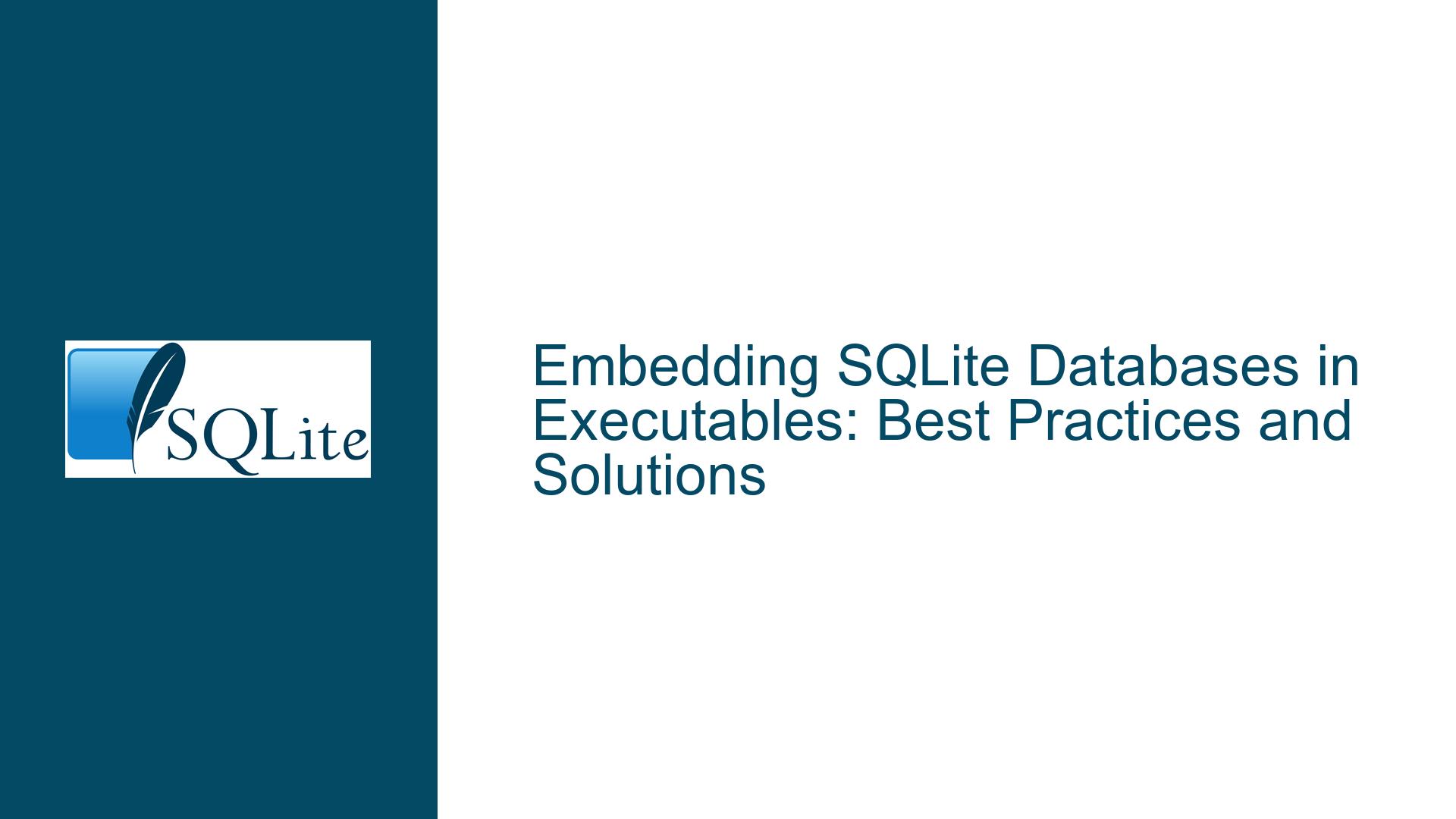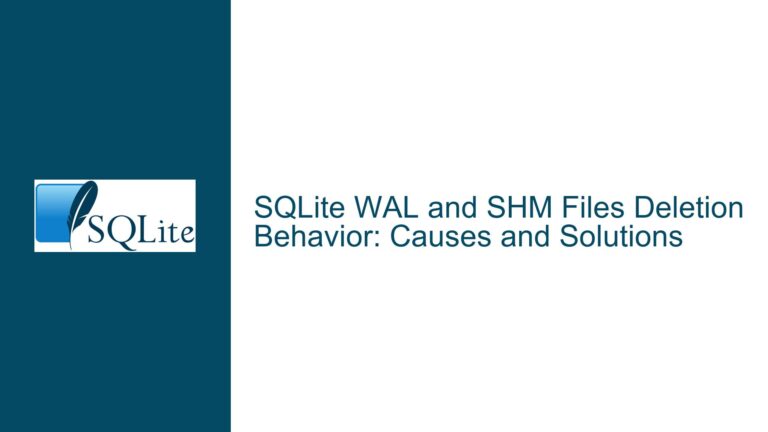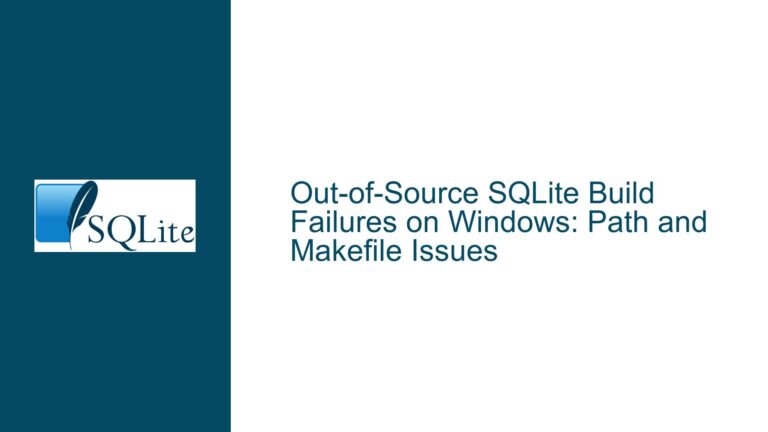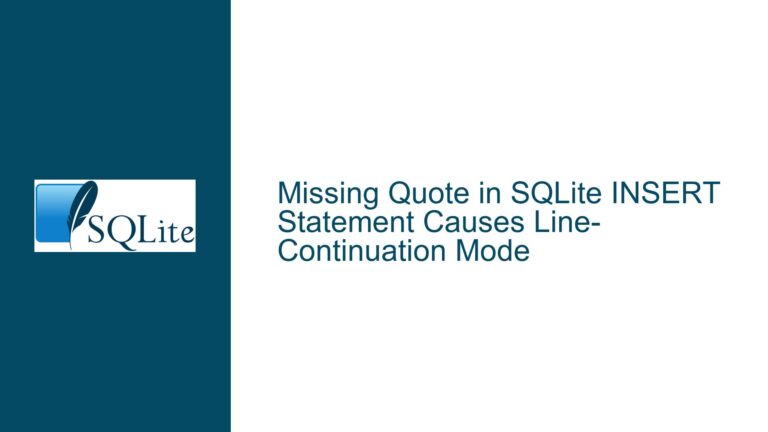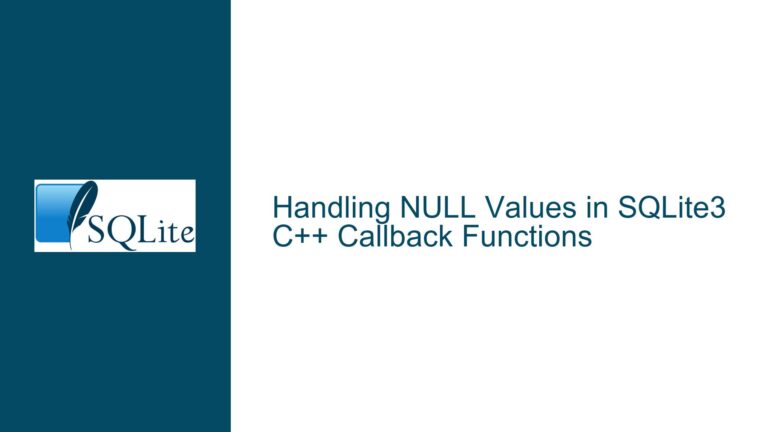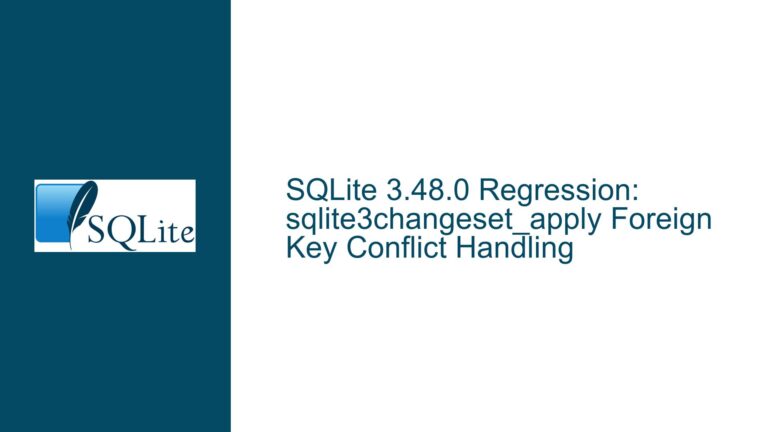Embedding SQLite Databases in Executables: Best Practices and Solutions
Issue Overview: Embedding SQLite Databases in Executables
Embedding a SQLite database within an executable is a common requirement for developers who want to distribute pre-computed data alongside their applications. This approach ensures that the application has immediate access to the data without requiring external files or complex setup procedures. However, this task involves several technical challenges, including how to store the database within the executable, how to generate the necessary SQL statements or binary data, and how to write the database to disk when the application is first executed.
The primary goal is to embed the SQLite database in such a way that it can be seamlessly integrated into the executable, ensuring that the database is accessible and usable when the application runs. This involves considerations such as endianness, platform independence, and the ability to handle large datasets. Additionally, the embedded database should be easily accessible and, if necessary, modifiable by the application.
Possible Causes: Challenges in Embedding SQLite Databases
One of the main challenges in embedding a SQLite database within an executable is ensuring that the database is stored in a format that is both platform-independent and easily accessible. Storing the raw bytes of the database in a char[] array within a .c file may seem straightforward, but this approach can fail if the endianness of the architecture changes. Endianness refers to the order in which bytes are arranged within larger data types, such as integers. If the executable is run on a system with a different endianness than the one on which the database was created, the database may become corrupted or unreadable.
Another challenge is generating the necessary SQL statements to recreate the database. While the SQLite CLI provides a .dump command that can generate these statements, integrating this functionality into a C application requires additional steps. The generated SQL statements must be stored in a format that can be easily executed by the application, and the application must be able to handle potentially long strings of SQL code.
Writing the database to disk also presents challenges. The sqlite3_exec function can execute SQL statements, but it may not be suitable for handling very long strings or large datasets. Additionally, the application must ensure that the database is written to a location where it can be accessed and modified as needed. This may involve handling file permissions and ensuring that the database is stored in a standard location, such as the user’s Documents folder.
Finally, there are considerations around the security and modifiability of the embedded database. Executables are often marked as read-only for security reasons, which means that any database embedded within the executable may also be read-only. If the application needs to modify the database, it may need to create a writable copy of the database on disk.
Troubleshooting Steps, Solutions & Fixes: Embedding SQLite Databases in Executables
To address the challenges of embedding a SQLite database within an executable, several solutions and best practices can be employed. These include using the SQLite Backup API, leveraging the Append VFS, and considering alternative approaches such as self-extracting ZIP files.
Using the SQLite Backup API
The SQLite Backup API is a powerful tool for creating and managing backups of SQLite databases. This API can be used to create a backup of the database and store it within the executable. When the application is first executed, the backup can be restored to a writable location on disk, ensuring that the database is accessible and modifiable.
To use the Backup API, the application must first create a backup of the database using the sqlite3_backup_init function. This function initializes a backup object that can be used to copy the contents of the source database to the destination database. The backup process can be controlled using the sqlite3_backup_step and sqlite3_backup_finish functions, which allow the application to specify how much data is copied in each step and to finalize the backup process.
Once the backup is created, the application can store the backup data within the executable. This can be done by converting the backup data into a char[] array or by storing the backup data in a separate file that is appended to the executable. When the application is executed, it can restore the backup to a writable location on disk using the sqlite3_backup_init and sqlite3_backup_step functions.
Leveraging the Append VFS
The Append VFS is a specialized virtual file system (VFS) that allows a SQLite database to be appended to the end of an executable. This approach is particularly useful for read-only databases, as it allows the database to be stored within the executable without requiring additional files or complex setup procedures.
To use the Append VFS, the application must first register the VFS with the SQLite library using the sqlite3_vfs_register function. Once the VFS is registered, the application can open the database using a URI file specifier that includes the vfs=apndvfs parameter. This tells SQLite to use the Append VFS to access the database, which is located at the end of the executable.
When the application is executed, it can open the database using the sqlite3_open_v2 function with the appropriate URI file specifier. The database can then be accessed as usual, with the Append VFS handling the details of reading the database from the executable.
If the application needs to modify the database, it can create a writable copy of the database on disk using the sqlite3_backup_init function or the VACUUM INTO statement. This allows the application to maintain a read-only version of the database within the executable while still providing the ability to modify the database as needed.
Considering Alternative Approaches: Self-Extracting ZIP Files
Another approach to embedding a SQLite database within an executable is to use a self-extracting ZIP file. This approach involves appending a ZIP file containing the database to the end of the executable. When the application is executed, it can extract the database from the ZIP file and write it to a writable location on disk.
The ZIP file format is particularly well-suited for this purpose, as it places the table of contents at the end of the file. This allows the application to easily locate and extract the database, even if it is appended to the end of the executable. Most ZIP libraries interpret offsets relative to the table of contents, making it easy to work with ZIP files that are appended to other files.
To implement this approach, the application must first create a ZIP file containing the database. This can be done using any standard ZIP library or tool. The ZIP file is then appended to the end of the executable using a simple file concatenation operation.
When the application is executed, it can open the executable as a ZIP file using a ZIP library. The library will interpret the appended ZIP file as a normal ZIP file, allowing the application to extract the database and write it to a writable location on disk. This approach provides the added benefit of compression, reducing the size of the executable and the embedded database.
Best Practices for Embedding SQLite Databases
When embedding a SQLite database within an executable, it is important to follow best practices to ensure that the database is accessible, modifiable, and secure. These best practices include:
Platform Independence: Ensure that the database is stored in a platform-independent format. This can be achieved by using the SQLite Backup API or by storing the database as SQL statements that can be executed to recreate the database.
Version Control: Use version control to manage changes to the database schema and data. This can be done by storing the SQL DDL and DML statements necessary to create the database in the C source code, using an array of C-string literals for each statement.
Security: Consider the security implications of embedding a database within an executable. Executables are often marked as read-only for security reasons, so any database embedded within the executable may also be read-only. If the application needs to modify the database, it should create a writable copy of the database on disk.
Performance: Optimize the performance of the embedded database by using efficient SQL statements and indexing. This can be done by analyzing the database schema and queries, and by using tools such as the SQLite EXPLAIN QUERY PLAN statement to identify and address performance bottlenecks.
Testing: Thoroughly test the embedded database on all target platforms to ensure that it is accessible and usable. This includes testing on systems with different endianness, file systems, and operating systems.
By following these best practices and leveraging the appropriate tools and techniques, developers can successfully embed SQLite databases within their executables, ensuring that their applications have immediate access to the data they need.
